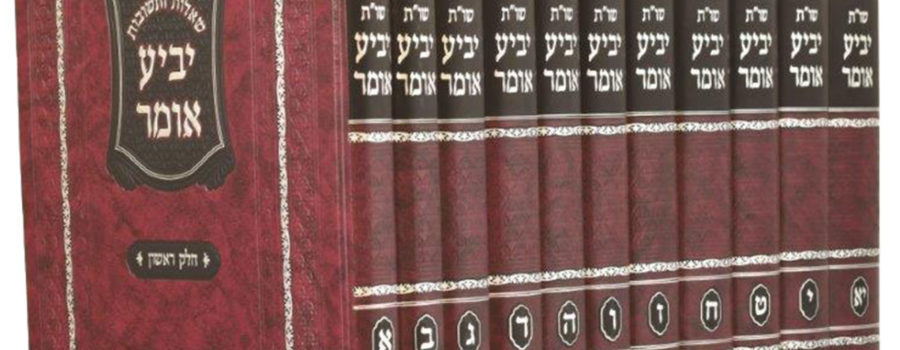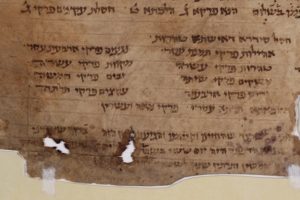Unveiling the Marginalia: New Edition of Rav Herzog’s Responsa Heichal Yitzhak Features Annotations by Maran Ovadiah Yosef
In 2015, the family of late Maran Ovadiah Yosef, the former Sephardic Chief Rabbi of Israel and revered Rishon LeZion, introduced a remarkable new edition of his highly regarded responsa works. This edition encompassed ten volumes of Responsa Yabia Omer and six volumes of Responsa Yehaveh Da’at. Subsequently, an additional volume was published for Yabia Omer, making it eleven volumes in total, and a seventh volume for Yehaveh Da’at was also added. Additionally, a comprehensive index volume was included, spanning across all these volumes and meticulously cataloging their contents. This New Edition stands out from previous ones due to the inclusion of Maran Ovadiah Yosef’s personal annotations, also known as marginalia, found at the bottom of the relevant pages. These annotations are taken directly from the margins of his own published copies of the works, effectively imbuing his books with the essence of manuscripts when viewed in the context of these dual layers of his writings. This exceptional feature grants us, as readers, the invaluable opportunity to delve deeper into his thought process by examining the notes he made in his own volumes.
The initiative to integrate Maran Ovadiah Yosef’s annotations into his responsa volumes began during his lifetime. Recognizing their immense value, a dedicated committee of distinguished scholars, chavrutot, and close family members was assembled to oversee this significant undertaking and established Machon Meor Yisrael. After Maran Ovadiah Yosef’s passing in 2013, the committee continued their mission, redoubling their efforts to fulfill his desire to share his insightful annotations with a broader audience. In 2015, the first volumes of Yabia Omer and Yehaveh Daat were released, featuring Maran Ovadiah Yosef’s annotations on the bottom of the pages. The new edition of Maran Ovadiah Yosef’s responsa volumes is an invaluable resource for scholars and students of halakhah. While the bedrock of his religious teachings and interpretations remains unchanged, this edition offers a deeper understanding through the inclusion of his personal marginalia. Maran Ovadiah Yosef’s handwritten notes, delicately written within the margins of his personal copies that grace the shelves of his library, offer profound insights into his analytical approach regarding the topics addressed in each responsum. Engaging with these annotations is akin to having a personal dialogue with Maran Ovadiah Yosef himself, making this new edition an essential prerequisite for anyone wishing to fully appreciate or study his responsa. (I distinctly remember engaging in a discussion with a consultant to the primary financier of this project at a wedding in New York on the day that the first copies of the new editions appeared in print. They shared with me the astounding fact that the entire initial run of the series had been completely purchased, even before the books could physically leave the warehouse. This led to an immediate necessity for further printings to meet the extraordinary demand.)
These updated marginalia and annotations are exclusively available in the physical print versions of Maran Ovadiah Yosef’s works and are not included in digital copies found in online electronic databases. To fully explore and engage with these invaluable annotations, readers must delve into the tangible print editions. These annotations not only illuminate the contextual backdrop in which the responsa were penned but also unveil the sources and references he consulted, including, for example, subsequent sources that eluded him during his early years as a Rabbi in Cairo in the late 1940s. It is important to note that during this period, his access to the extensive rabbinic library that would eventually adorn his Jerusalem home was limited, making these marginalia particularly informative and enlightening. For a glimpse into his vast rabbinic library that would later enrich his home in Jerusalem, please refer to this TikTok recording, which calls to mind the library of Umberto Eco. I am not aware that a full catalogue of the rabbinic library of Maran Ovadiah Yosef has been made publicly available, though if anyone has any additional information, please let me know! In a more recent video, Maran Ovadiah Yosef’s son, Maran Yitzhak Yosef, who currently serves as Rishon LeZion and Sephardic Chief Rabbi of Israel, described that his father’s library had more than 20,000 books, which he describes in the video here. By the way, the soundtrack to the above TikTok of Maran’s library is a remixed version of the song “God Can Do Anything,” with the original by Kobi Peretz & Haim Israel, available here, and with English subtitles here; and for an oontz-oontz remix version, see here. I recall thinking when I first viewed the footage, that a more fitting melody would be Yaakov Shwekey’s Maran Sheli. Indeed, an exploration of the musical tributes to Maran Ovadiah Yosef – both in terms of the rhythms and the lyrics – remains a scholarly desideratum! But I digress.
Several weeks ago was the 64th yahrzeit of Rav Yitzhak Isaac ha-Levi Herzog, the first Ashkenazic Chief Rabbi of the State of Israel, on the 19th of Tammuz, when the Herzog family around the world will observe the yahrzeit of their patriarch. In recent months, Yad ha-Rav Herzog, the official rabbinic publishing arm of the Herzog family, has published a new edition of Rav Herzog’s Responsa Heichal Yitzhak, vol. 1, on Orah Hayyim. This development aligns with the commemoration of the yahrzeit, providing an opportunity for individuals to engage with the wisdom and teachings of Rav Yitzhak Isaac ha-Levi Herzog through the updated edition of his responsa. Introducing the new and annotated edition of Heichal Yitzhak is Mr. Isaac Herzog, the distinguished grandson of Rav Yitzhak Isaac ha-Levi Herzog, sharing his namesake. Presently serving as the President of the State of Israel, Isaac Herzog follows in the footsteps of his late father, General Chaim Herzog, who held the same position. It is worth noting that General Michael Herzog, President Herzog’s brother, currently serves as the Israeli Ambassador to the United States. Last year, I had the privilege of welcoming Ambassador Michael Herzog to Harvard University, where I had the honor of guiding him through the Harvard Library Judaica Collection. During the visit, we explored a wide range of materials, including books, pamphlets, journals, photographs, and various historical artifacts, some of which were relevant to his own family’s history. I also shared with him insights from my recent article in Menachem Butler, “Harvard Judaica Collection as a Resource for Harvard Law School’s Julis-Rabinowitz Program on Jewish and Israeli Law,” Harvard Judaica, no. 9 (Winter 2021-2022): 12-15, available here. Following our engaging meeting, Ambassador Herzog graciously invited me to attend the Israeli Embassy’s Yom Haatzmaut celebration in Washington DC, which I attended the following month.
Now, returning our attention back to the new edition of Rav Herzog’s Heichal Yitzhak, President Isaac Herzog provides the introductory words, emphasizing three significant areas in which his grandfather made a profound impact on the State of Israel. President Herzog notes that his grandfather composed the monumental prayer for the welfare of the State of Israel, breathed new life into the rabbinical court system, and his unwavering dedication led him to tirelessly navigate the intricate balance of the State of Israel as a Jewish and Democratic state. This enduring and existential concern remains ever-relevant and holds paramount significance, not only for the present generation but also for shaping the future of the State of Israel. As President Herzog writes in his Introduction: “We, as the third generation, proudly bear the torch of their legacy and commitment to this mission, and we pass it on to our children and future generations.” Moreover, in his recent laudatory preface to the celebratory volume of the Encyclopedia Talmudit, vol. 50 (2023), President Isaac Herzog eloquently praised the ongoing undertaking, which was initially established by his revered grandfather, Rav Herzog, and is now steadily progressing towards its ultimate culmination in the forthcoming years.
I mentioned above Maran Yitzhak Yosef, who currently serves as Rishon LeZion and Sephardic Chief Rabbi of Israel, and to this new volume of Rav Herzog’s “Heichal Yitzhak,” with the marginalia notations of Maran Ovadiah Yosef, he writes as an approbative blessing that he recalls that his saintly father Maran Ovadiah Yosef told him “that he had never seen such a unique and profound scholar [as Rav Yitzhak Isaac ha-Levi Herzog], whose entire being was immersed in the study of the Talmud and whose leadership was conducted at an exceptional level. He resolved difficult and intricate questions and possessed the audacity to rule on matters that the decisors had not yet deliberated upon, such as the kosher status of Ethiopian Jews, being the first to firmly establish their Jewishness… [Rav Herzog’s] eminence in Torah and his proficiency in the works of the halakhic decisors were not without merit, and he is regarded as one of the preeminent halakhic decisors of his time.” It was with the explicit permission of Maran Yitzhak Yosef that this new volume includes the annotations from his own copies of Rav Herzog’s “Heichal Yitzhak,” and which are now published for the first time. In this new volume, the marginal notes composed from Maran Ovadiah Yosef and taken from his personal copy of the Heichal Yitzhak of Rav Herzog, are expounded upon by Maran Yitzhak Yosef, employing a methodology akin to that which he uses in his own rabbinic works pertaining to his father.
It is beyond the scope of this post to explore the full jurisprudential contributions of Rav Herzog, but for his important contributions published prior to his ascent to the position of Ashkenazic Chief Rabbi of the State of Israel, see two-volume work The Main Institutions of Jewish Law (vol. 1 in 1936; and vol. 2 in 1939), and in 1989, Yad ha-Rav Herzog published a monumental three-volume work of writings by Rav Herzog that cover a wide range of topics, including the dynamics of government and law, proposed enactments concerning inheritance laws, and the constitution, laws, and enactments of the Chief Rabbinate. Through meticulous analysis and profound insights, Rav Herzog offers a significant contribution to our understanding of the interplay between Jewish law, constitutional considerations, and contemporary legal issues in a Jewish state.
This material, and others produced by Yad ha-Rav Herzog and other scholars in Israel and around the world, proved quite helpful to me last year, in my work at The Julis-Rabinowitz Program on Jewish and Israeli Law at Harvard Law School, where I prepared a semester-long seminar on “Legal Pluralism vs. Legal Centralism in Jewish Thought,” with the fifth session exploring the writings of Rav Yitzhak Isaac ha-Levi Herzog, with a particular emphasis on his works related to the relationship between Jewish law and the State of Israel. Sources from Rav Herzog’s writings that were discussed that day included his essay in “Torah Law and State Law,” Talpiyot, vol. 7, no. 1 (October 1957): 4-32 (Hebrew), among many other sources.
The secondary readings to that class offered a comprehensive examination of the debates and discussions surrounding the interplay between Jewish law and the establishment of the State of Israel. The session aimed to offer insights into the legal theories and perspectives that shaped the relationship between religious and secular law in the State of Israel. For a sample of some of the sources that were included, see Eliav Shochetman, “The Halakha’s Recognition of The Laws of The State of Israel,” Shenaton ha-Mishpat ha-Ivri, vol. 16-17 (1990-1991): 417-500 (Hebrew); and Eliav Shochetman, “Rabbi Isaac Herzog’s Theory of Torah and State,” Jewish Law Association Studies, vol. 5 (1991): 113-125; Itamar Warhaftig, “Rabbi Herzog’s Approach to Modernity,” in Moshe Z. Sokol, ed., Engaging Modernity: Rabbinic Leaders and the Challenge of the Twentieth Century (Northvale, NJ: Jason Aronson, 1997), 275-319; Aviezer Ravitzky, “Is a Halakhic State Possible? The Paradox of Jewish Theocracy,” Israel Affairs, vol. 11, no. 1 (2005): 137-164, available here; Joseph Tabory, “The Piety of Politics: Jewish Prayers for the State of Israel,” in Ruth Langer and Steven Fine, eds., Liturgy in the Life of the Synagogue: Studies in the History of Jewish Prayer (Winona Lake, Indiana: Eisenbrauns, 2005), 225-246, available here; and Shulamit Eliash, “Rabbi Herzog, de Valera, and Jewish Rescue,” in The Harp and the Shield of David: Ireland, Zionism and the State of Israel (London and New York: Routledge, 2007), esp. 49-69, 190-195.
As well, there have also recently been a number of important books that might be of interest, and those are by Alexander Kaye, The Invention of Jewish Theocracy: The Struggle for Moral Authority in Modern Israel (Oxford: Oxford University Press, 2020); Asaf Yedidya, Halakha and the Challenge of Israeli Sovereignty (Lanham, MD: Lexington Books, 2019); Avraham Steinberg, Prayers for the Welfare of the State and For the Welfare of the State of Israel (Jerusalem: Yad ha-Rav Herzog, 2012); and most recently, see Joel Rappel, Politics and Prayer: Jewish Prayers for the Government and the State of Israel (Brooklyn: Ktav Publishing House, 2023), which includes a Foreword by President Isaac Herzog, who writes:
“Each morning, upon entering the Office of the President of the State of Israel, I am greeted by the handwritten text of my grandfather. Rabbi Yitzhak Isaac Halevi Herzog of blessed memory. His timeless composition, Tefillah le-Shlom ha-Medinah – “Prayer for the Welfare of the State,” first publicized ahead of the Jewish New Year 5709 and now proudly displayed opposite my desk, is far more than a decorative family souvenir. It is a liturgical study of profound theological depth, which aims to fundamentally encapsulate the spiritual awakening of the Jewish Nation. For me, reciting my grandfather’s poignant verses in the heart of Jerusalem aligns my inner compass. It crystalizes my mission as a member of the Jewish People and serves as an unambiguous reminder of my role as president of the only Jewish, democratic state in the world.” Reflecting on the visionary actions of his grandfather, President Herzog observes that though the Tefillah le-Shlom ha-Medinah was first composed in the Summer of 1948, the words penned by Rav Herzog resonate with remarkable relevance. For instance, the invocation to “Send Your light and truth to her leaders, ministers, and advisors” directly applies to his son, the sixth president Chaim Herzog, as well as to President Herzog himself, the eleventh president, who bears the name of his revered grandfather.




